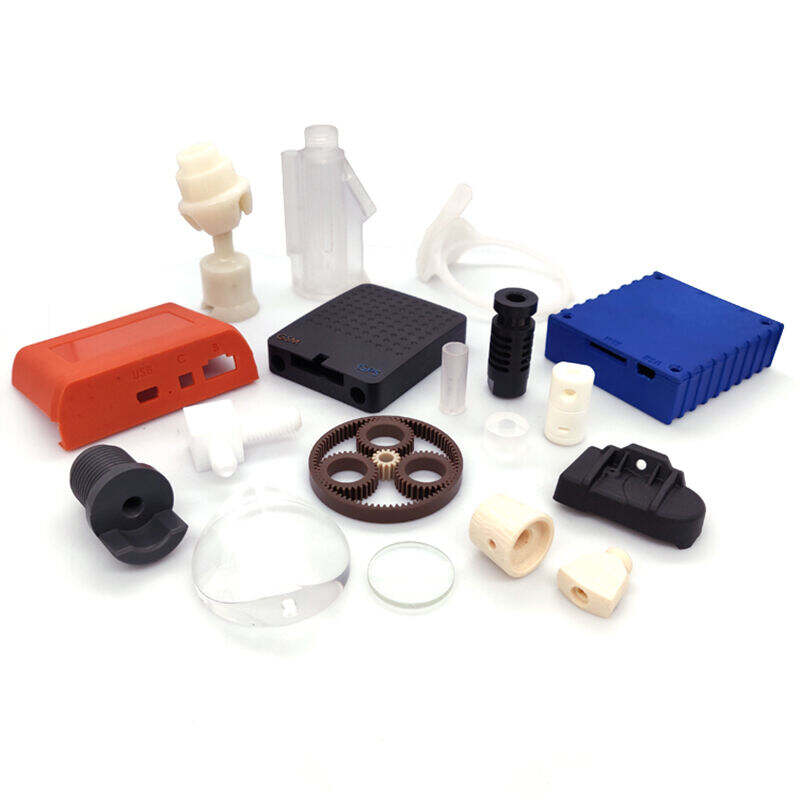1. מהו עיבוד CNC מדויק?
עיבוד CNC (בקרת מספרית ממוחשבת) מדויק הוא תהליך ייצור חלקי, שבו תוכנה ממוחשבת מוקדמת קובעת את תנועת כלים ומכונות במפעל. אוטומציה זו מאפשרת ייצור של חלקים מורכבים עם דיוק ונשנות יוצאי דופן , מעבר להישג ידיעת של עיבוד קונבנציונלי .
ההבדל הבסיסי בין עיבוד CNC סטנדרטי לעיבוד מדויק נמצא ברמת הדיוק. בעוד שעיבוד סטנדרטי עשוי להיות מספיק עבור רכיבים כלליים, עיבוד מדויק כולל בדרך כלל סובלנות הנעה בין ±0.1 עד 0.2 מילימטרים , מכונות ייעודיות, פרמטרי חיתוך אופטימליים וטיפול מקצועי כדי להשיג תקנים מדויקים כל כך . המטרה העיקרית היא ייצור המוני של רכיבים זהים לsectors דרמטיים כמו תעשיית הרכב, הרפואה וההגנה, שם סטייה של מיקרון אחד יכולה להיות קריטית.
מקרה מציאותי: מהדגם CAD לרכיב תעופתי
יצרן היה צריך לאחרונה שורה של מחזיקי מבנה בעלי ביצועים גבוהים למטוס. האב-טיפוס הראשוני, שנעשה על מכונת CNC תלת-צירית רגילה, הראה סטיית 0.15 מ"מ בבדיקות לחץ. על ידי מעבר למכונת CNC מדויקת בת חמישה צירים וadeshום התהליך שלב אחר שלב להלן, הם הגיעו לסובלנות עקיבה של 0.02 מ"מ ושיפור של 30% בחוזק החלק, ועברו את כל בדיקות האיכות לאישור טיסה.
2. תהליך עיבוד ה-CNC המדויק, שלב אחר שלב
השגת דיוק גבוה מחייבת תהליך רב שלבי ומדויק.
2.1 עיצוב ודגם CAD
המסע מתחיל עם מודל תלת-ממדי מפורט שנוצר בתוכנה כמו AutoCAD או Solidworks . המודל כולל את כל המידות, הסובלנות והתכונות הקריטיות של החלק הסופי. חשוב להקפיד על עקרונות אלו בשלב זה כדי להבטיח שהעיצוב יתאים לטכניקות עיבוד מדויקות ולמנוע תכונות שקשה או יקר מדי לעבד של החלק הסופי. חשוב להקפיד על עיצוב עבור ייצור (DFM) עקרונות אלו בשלב זה כדי להבטיח שהעיצוב יתאים לטכניקות עיבוד מדויקות ולמנוע תכונות שקשה או יקר מדי לעבד .
2.2 CAM ותכנות CNC
לאחר מכן, מודל ה-CAD מיובא אל ייצור בעזרת מחשב (CAM) התוכנה. מערכת ה-CAM מתרגמת את המודל לקבוצת הוראות, הידועה בשם G-code ו-M-code , שמכונת ה-CNC יכולה לבצע. שלב זה כולל סימולציה של מסלולי הכלים כדי למזער שגיאות ולשפר את תהליך הסרת החומר לצורך דיוק מרבי .
2.3 הגדרת מכונת CNC
הגדרה נכונה היא חובה מוחלטת. שלב זה כולל:
-
הגדרת כלים: התקנת כלי חיתוך מתאימים (כגון קצות חיתוך, מקדחים וכו') לתוך מחזיקי הכלים או להחליף כלים אוטומטי (ATC).
-
אחזקת חלק: אфиксצית החומר הראשוני (החלק) בצורה יציבה על משטח המכונה או צ'אק באמצעות קלמפס או אביזר אחזקת חלק.
הגדרה שגויה, כגון סטיית כלי או יישור לא נכון, היא סיבה נפוצה לפגמים איכותיים חמורים בחלקים מדויקים .
2.4 ביצוע עיבוד ומעקב בתהליך
שלב זה הוא שלב העיבוד הפיזי. הפועל מגדיר פרמטרים כמו מהירות ציד, קצב תזונה, ועומק חיתוך . עבור סוגר טיטנייאם לתחום התעופה, הפרמטרים יכולים להיות:
-
מהירות ציד: 2400 סל"ד
-
קצב תזונה: 0.2 מ"מ לדנט
-
עומק חיתוך: 0.5 מ"מ (עבור מעברי גימור)
למכונות מודרניות יש לעיתים קרובות חישורים שבודקים ניפוח כלים וממדים של חלקים בזמן אמת , מה שמאפשר התאמות לשמירה על עקביות לאורך ריצת ייצור.
2.5 עיבוד לאחר החריטה וסיום
לאחר החריטה, לעתים קרובות מבוצעת עיבוד נוסף לחלקים. זה כולל חידוד הסרת קצוות חדים ו- גימור שיפור איכות המשטח. טכניקות כמו צמצום יכולים להשיג דיוק ממדי סופי, בעוד ש- שיזוף או אנודה יכולים לשפר עמידות בתולעים ומראה כללי .
טבלה: תהליכי גימור CNC נפוצים וההשפעה שלהם
3. סוגי מכונות CNC מדויקות ויישומיהן
משימות מדויקות שונות דורשות מכונות מיוחדות. להלן הסוגים המרכזיים של מכונות CNC המשמשות בייצור עתיר דיוק:
-
מכונות חיתוך CNC: משתמשות בכלים רב-נקודות מסתובבים כדי להסיר חומר מקטע עבודה סטטי. אידיאלי ליצירת גאומטריות מורכבות, חריצים וכיסים עם סובלנות עד ±0.0025 ממ . מכונות חיתוך 5 צירים חיוניות לרכיבים מורכבים בתעשיית התעופה והרפואה.
-
מכונות טorno ומרכזי עיבוד: חתך העבודה מסתובב בזמן שמכונת חיתוך חד-קודקודית זזה בקו ישר כדי להסיר חומר. זו השיטה העיקרית לייצור חלקים ציריםימטריים כמו גלילים, צירים ומחברים .
-
עיבוד CNC באמצעות פריקת חשמל (EDM): תהליך שאינו במגע, המשתמש בפרקי חשמל לקלוף חומר, אידיאלי למתכות קשות כמו טיטניום וטונגסטן. התהליך יוצר מתח מכני מינימלי והוא מושלם לצורות מורכבות כמו תבניות וכלי גזירה .
-
מגרדים Преיסיזיה CNC: משמשים כפעולת גימור, מכונות אלו משתמשות בגל רתך מסתובב כדי להשיג משטחים חלקים במיוחד וסיבולת הדוקה, לעתים קרובות בתור הצעד האחרון לפני השלמת החלק .
4. בחירת חומר לחלקיה Преיסיזיה של CNC
בחירת החומר היא גורם קריטי המשפיע על אסטרטגיית העיבוד, הכלים והביצועים הסופיים של החלק.
מתכות ותרכובות
-
אלומיניום 6061, 7075: יחס חוזק-למשקל מעולה, נטוליות עיבוד טובה. בשימוש נרחב בתעופה וברכב.
-
פלדת אל חלד 304, 316: מציע עמידות גבוהה בפני שזיפה. נפוץ במכשירי רפואה ובהתקני עיבוד מזון.
-
טיטניום (Ti-6Al-4V): חוזק גבוה, קל משקל והתאמה ביולוגית, אך קשה לעבד. חיוני לתעשיית התעופה ולשתלים רפואיים .
-
אינקונל 718: Сплав ניקל בסיסי עם עמידות חום מעולה, בשימוש במנועי סילון ויישומים בטמפרטורות גבוהות.
פלסטליקה ופולימרים
-
PEEK (פוליאתר אתר קטון): עמידות תרמית וכימית גבוהה, בשימוש לעיתים קרובות כהחלפה למתכת בתחום הרפואי והתעופתי.
-
אקetal (POM): חיכוך נמוך וקשיחות גבוהה, אידיאלי לגלגלי שיניים ומסבבים.
-
PTFE (טפלון): עמידות כימית מעולה וחיכוך נמוך, בשימוש בחיבורים וברכיבי בידוד .
טבלה: מדריך לבחירת חומרי CNC מדויקים
| חומר | תכונות עיקריות | מתאימה ביותר עבור | שיקול בעריכה |
|---|---|---|---|
| אלומיניום 6061 | קל במשקל, עמידות טובה, עמיד בפני ש corrosion | חלקי רכב, מסגרות תעופתיות, כיסויים אלקטרוניים | קל לעבד, דורש כלים חדים |
| פלדה חלודה 316 | עמידות מעולה בפני שפיכות, חזק | התקני רפואה, יישומים ימיים, מיכלי כימיקלים | קשה יותר לעבד, דורש התקנה קשיחה |
| טיטניום Ti-6Al-4V | חוזק גבוה מאוד, קל במשקל, תואם ביולוגית | רכיבי מטוסים, שתלים רפואיים | קשה לעיבוד, מהירויות/תזונה איטיות |
| פיק | עמידות לטמפרטורות גבוהות, חזק, תואם ביולוגית | שתלים רפואיים, תעופה וחלל, חלקים ביצועיים גבוהים | עובר עיבוד טוב, אך רגיש לחום |
5. תחומי תעסוקה מרכזיים ויישומים של עיבוד מדויק
חלקי CNC מדויקים הם יסודיים בתעשיות שבהן כשל אינו אפשרות
-
תעופה וחלל: רכיבים כגון להבי טורבינה, סוגריים מבניים, ומדפי חום דורשים דיוק ואמינות קיצוניים בתנאים קיצוניים . דוגמה מחיי היום-יום היא עיבוד של להבי טורבינה מ-Inconel 718 , אשר חייבים לעמוד בדרישות של טמפרטורות מעל 1300° צלזיוס וכוחות צנטריפוגליים, ודורשים עיבוד בדיקת חשמל (EDM) ועיבוד בעשרה צירים כדי להשיג את הגאומטריה הנדרשת של ערוצי הקירור והגימור המדויק של המשטח.
-
רפואי: התחום הרפואי מסתמך על עיבוד מדויק עבור כלי ניתוח, שתלים אורתופדיים (ברכיים, ירכיים) ושיננית דנטלית . למשל, שִׁתְל גולגולתי מטיטניום מותאם אישית נעשה לעתים קרובות לפי נתוני סריקה של CT מדויקים של המטופל, עם מבנה משטח מחורר שנעבד במטרה לקדם התחדרות עצם.
-
רכב: התעשייה משתמשת בעיבוד מדויק עבור מחזיקים מותאמים אישית, רכיבי מנוע וחלקי תמסורת .מנועים בעלי ביצועים גבוהים כוללים פיסות שטופלו בהפרשים מיקרוניים כדי להבטיח חיבורים מושלמים ולצמצם את החיכוך, מה שמעלה ישירות את כוח הסוס והיעילות
-
אלקטרוניקה: עיבוד באמצעות CNC מדויק מייצר פנסים, מחברים ותיבות קומפקטיות למחשבים אישיים ולהתקני נייד, שם חשובה עשויה הקטנה וניהול תרמי .
6. כיצד בוחרים ספק שירותי עיבוד מדויק
בחירת שותף ייצור נכון היא קריטית. להלן הגורמים המרכזיים על פי עקרונות EEAT:
-
ביסוס וניסיון: חפשו ספק עם תולדות הוכחה בתחום שלך. התבקשו מחקרים או דוגמאות של חלקים דומים שהם יצרו. לצוות שלהם צריכים להיות מהנדסים וטכנאי עיבוד מאומנים.
-
מוניטוריות ואמינות: בדקו עבור אישורים (למשל, ISO 9001, AS9100 לתעופה וחלל, ISO 13485 לרפואה) . אלו מראים על מחויבות למערכות ניהול איכות. קראו עמדות לקוחות וביקורות.
-
יכולת טכנית: ודאו כי יש להם המכונות המתאימות (למשל, מכונות חיתוך 5 צירים, מסובים מסוג שוויצרי) ו ציוד מדידה (למשל, CMMs) כדי לאמת את הסיבויות הנדרשות.
-
תקשורת ושקיפות: שותף מהימן מספק מידע ברור פידבק DFM ומקיים תקשורת פתוחה לאורך כל הפרויקט.


